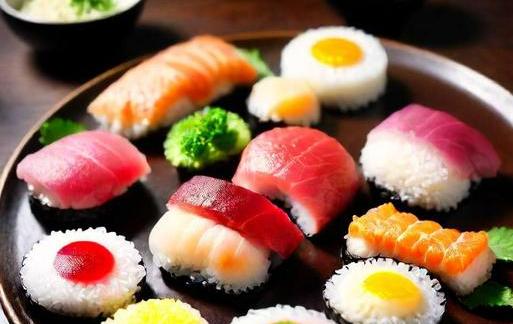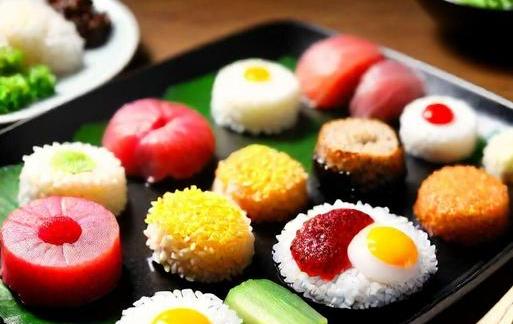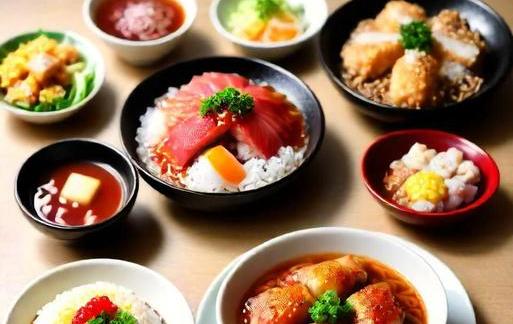- You are here:
- Home »
- Food
- » [REVEALED] Japanese Foods That Start With F
[REVEALED] Japanese Foods That Start With F
Note: This page contains affiliate links.
As an Amazon Associate, I earn from qualifying purchases when you click on the link, but you are not charged extra.
Japanese cuisine is renowned for its exquisite flavors, meticulous preparation, and diverse range of dishes. As we embark on a culinary journey through the rich tapestry of Japanese foods, we focus on a specific letter of the alphabet – F. In this article, we delve into the world of Japanese foods that start with F, uncovering unique flavors, traditional recipes, and the cultural significance behind each dish. From savory to sweet, the Japanese culinary landscape offers a delightful array of options that showcase the country’s culinary prowess.
Contents
List Of Japanese Foods That Start With F

1. Fugu (河豚)
Description:
Fugu, or pufferfish, is a delicacy in Japanese cuisine, known for its potentially lethal poison. Served in specialized restaurants by licensed chefs, Fugu is meticulously prepared to ensure the removal of toxic parts. The thrill of dining on Fugu lies not just in its taste but in the artistry and skill required to prepare it safely.
Preparation:
Chefs must undergo extensive training to obtain a license to prepare Fugu. The poisonous organs, particularly the liver, are carefully removed, leaving behind a non-lethal yet flavorful dish. Fugu is often served sashimi-style, thinly sliced and accompanied by a soy-based dipping sauce.
Cultural Significance:
Fugu has a long history in Japanese culture, dating back to the Edo period. Despite the risks associated with its consumption, many Japanese people are drawn to the thrill of eating this potentially dangerous delicacy. Fugu restaurants are highly regulated to ensure the safety of diners.
2. Furikake (ふりかけ)
Description:
Furikake is a seasoning blend that adds flavor to rice, noodles, and other dishes. Typically consisting of dried fish, sesame seeds, chopped seaweed, sugar, salt, and monosodium glutamate, Furikake imparts a burst of umami to plain rice, transforming it into a flavorful accompaniment.
Preparation:
Furikake is often sprinkled over rice or mixed into dishes to enhance their taste. It comes in various flavors, with some versions containing ingredients like bonito flakes, shiso, or wasabi for added complexity.
Cultural Significance:
Widely used in Japanese households, Furikake is a convenient way to elevate the taste of simple meals. Its popularity can be attributed to its versatility and the ease with which it can enhance the overall dining experience.
3. Futomaki (太巻き)
Description:
Futomaki, translating to "thick roll," is a type of sushi roll distinguished by its larger size and varied fillings. Unlike traditional maki rolls, Futomaki often contains a combination of vegetables, fish, and occasionally, a sweet omelet. The colorful and flavorful ingredients make it a visually appealing and satisfying dish.
Preparation:
To prepare Futomaki, a sheet of nori (seaweed) is laid on a bamboo mat, and a layer of sushi rice is spread over it. The chosen fillings are then arranged along the length of the rice, and the entire assembly is rolled tightly. Once rolled, the sushi is sliced into bite-sized pieces.
Cultural Significance:
Futomaki is a popular choice during celebrations and festivals. The variety of ingredients symbolizes abundance and prosperity, making it a favored dish for special occasions such as New Year’s celebrations and birthdays.
4. Fried Rice (チャーハン Or Yakimeshi 焼飯)
Description:
Known as "Chāhan" or "Yakimeshi," Japanese fried rice is a flavorful and comforting dish made with stir-fried rice, vegetables, and a choice of protein, such as chicken, pork, or shrimp. The dish often incorporates soy sauce and sesame oil, contributing to its savory and aromatic profile.
Preparation:
To prepare Japanese fried rice, cooked rice is stir-fried with a medley of vegetables and protein. The key lies in achieving the perfect balance of textures and flavors, with each ingredient contributing to the overall harmony of the dish.
Cultural Significance:
Fried rice is a staple in Japanese home cooking and is often enjoyed as a quick and satisfying meal. Its adaptability allows for creative variations, making it a versatile dish that can be customized to suit individual tastes.
5. Fukagawa Meshi (深川飯)
Description:
Fukagawa Meshi is a traditional dish originating from the Fukagawa area in Tokyo. It features a hearty bowl of rice topped with a flavorful mixture of clams, green onions, and soy-based broth. The combination of fresh seafood and aromatic green onions creates a dish that is both comforting and rich in umami.
Preparation:
The clams used in Fukagawa Meshi are often Asari clams, known for their sweet and briny flavor. The clams are cooked in a broth made from soy sauce, sake, and mirin, imparting a depth of flavor to the dish. The finished broth is poured over a bowl of hot rice, creating a satisfying and nourishing meal.
Cultural Significance:
Fukagawa Meshi is deeply rooted in the history of the Fukagawa area and reflects the connection between the local community and its seafood-rich environment. The dish is a testament to the importance of fresh, seasonal ingredients in Japanese cuisine.
6. Fried Gyoza (焼き餃子 Or Yaki Gyoza)
Description:
Gyoza, or Japanese dumplings, take on a delightful twist when they are pan-fried to a golden crispiness. The result is Yaki Gyoza, a savory and satisfying dish that showcases the contrast between the crunchy exterior and the juicy, flavorful filling.
Preparation:
Gyoza filling typically consists of ground meat, such as pork or chicken, finely chopped vegetables, and seasonings like garlic and ginger. The dumplings are then pan-fried until the bottoms become crispy, creating a delicious textural interplay with the soft steamed tops.
Cultural Significance:
Fried Gyoza is a popular appetizer or snack in Japan and is often enjoyed with a dipping sauce made from soy sauce, rice vinegar, and chili oil. Whether served as part of a meal or enjoyed on its own, Yaki Gyoza is a beloved dish that has found its way onto menus worldwide.
7. Fried Tofu (油揚げ Or Aburaage)
Description:
Fried tofu, known as Aburaage, is a versatile ingredient used in various Japanese dishes. Made by deep-frying thin slices of tofu, Aburaage has a slightly crispy texture on the outside while maintaining a tender and absorbent interior. It is often used as a component in soups, stews, and sushi rolls.
Preparation:
To make Aburaage, thin slices of tofu are deep-fried until they puff up and turn golden brown. The resulting product can be sliced, stuffed, or simmered in a flavorful broth, absorbing the surrounding flavors.
Cultural Significance:
Aburaage is a common ingredient in vegetarian and vegan Japanese dishes, providing a protein-rich and texturally satisfying element. It is widely used in traditional recipes and has become a staple in modern interpretations of Japanese cuisine.
Exploring Japanese foods that start with F offers a glimpse into the diverse and intricate world of Japanese cuisine. From the meticulous preparation of Fugu to the comforting appeal of Fried Rice and the cultural significance embedded in dishes like Futomaki and Fukagawa Meshi, each culinary creation tells a story of tradition, innovation, and the artistry of Japanese chefs. Whether savoring the delicate flavors of Furikake or indulging in the crispy satisfaction of Fried Gyoza, the Japanese dedication to quality ingredients and precise techniques shines through. As we conclude this culinary journey, it becomes evident that the foods highlighted here are not just sustenance; they are a celebration of flavors, textures, and the cultural heritage that defines Japanese gastronomy. So, the next time you embark on a Japanese culinary adventure, consider exploring the diverse and delicious offerings that start with the letter F – a testament to the richness of Japan's culinary tapestry.
Significance

Japanese cuisine is renowned worldwide for its exquisite flavors, meticulous preparation, and cultural significance.
Understanding the significance of foods starting with ‘F’ in Japanese cuisine requires delving into the cultural and historical roots that shape the culinary landscape. Japanese gastronomy is deeply intertwined with the country’s geography, seasons, and traditions. Each ingredient and dish carries a story, reflecting a harmonious blend of nature and human creativity.
The significance of foods starting with ‘F’ may extend beyond mere names, encompassing cultural rituals, festivals, and even symbolic meanings. By exploring these culinary elements, we gain insights into Japan’s rich heritage and the artistry embedded in its culinary traditions.
Category-Related

In the vast realm of Japanese cuisine, foods starting with ‘F’ span various categories, showcasing the versatility and innovation prevalent in the culinary scene. From traditional dishes passed down through generations to modern interpretations influenced by global culinary trends, the ‘F’ category encompasses a diverse array of flavors, textures, and cooking techniques.
Fish-based Delicacies
-
Fugu (河豚): Fugu, or pufferfish, holds a special place in Japanese cuisine due to its unique preparation and potential dangers. Skilled chefs undergo rigorous training to remove the toxic parts, offering patrons a rare and thrilling dining experience. Fugu is often served as sashimi, highlighting its delicate texture and subtle flavor.
-
Furikake (ふりかけ): While not a dish in itself, furikake is a seasoning blend commonly used in Japanese cuisine. It often contains dried fish, sesame seeds, chopped seaweed, sugar, salt, and monosodium glutamate, enhancing the flavor of rice, noodles, and various dishes.
Noodle Creations
- Fried Udon (炒めうどん): Udon, thick wheat noodles, take on a delightful twist when stir-fried. Mixed with vegetables, protein, and a savory sauce, fried udon showcases the adaptability of this versatile ingredient, offering a satisfying and flavorful dish.
Fermented Delights
- Furano Jam (富良野ジャム): Originating from Furano in Hokkaido, Furano jam is a delightful spread made from locally grown fruits. The fermentation process enhances the natural sweetness, resulting in a unique jam that adds a burst of flavor to bread, desserts, or even savory dishes.
Common Themes
Japanese foods that start with ‘F’ often share common themes rooted in the country’s culinary traditions. These themes, influenced by seasons, regional variations, and cultural practices, contribute to the depth and richness of each dish.
Seasonal Variations
- Fukinoto (ふきのとう): A seasonal delicacy, fukinoto refers to the buds of the giant butterbur plant. Usually enjoyed in spring, these buds are known for their unique bitterness and are often incorporated into tempura or used in hot pots, showcasing the importance of seasonal ingredients in Japanese cuisine.
Fusion Of Flavors
- Fried Mochi (揚げ餅): Mochi, a traditional Japanese rice cake, undergoes a flavorful transformation when fried. The crispy exterior contrasts with the chewy interior, creating a delightful fusion of textures. Often coated in soy sauce and topped with savory accompaniments, fried mochi exemplifies the creativity within Japanese culinary traditions.
Interesting Facts
Exploring the world of Japanese foods that start with ‘F’ unveils intriguing facts that add depth to the appreciation of these culinary delights. From historical anecdotes to cultural anecdotes, these facts provide context to the diverse range of dishes.
Fertility Symbolism
- Fuki (ふき): Fuki, or Japanese butterbur, not only serves as a culinary delight but also holds cultural significance. In Japanese folklore, fuki is considered a symbol of fertility. Its incorporation into dishes reflects a cultural connection between food and symbolism, adding layers of meaning to the dining experience.
Culinary Mastery
- Fukagawa-meshi (深川めし): Originating from the Fukagawa area in Tokyo, Fukagawa-meshi is a traditional dish that showcases the culinary mastery of the region. Consisting of simmered clams and rice cooked in a unique broth, this dish exemplifies the attention to detail and regional pride embedded in Japanese gastronomy.
Conclusion
In conclusion, exploring Japanese foods that start with ‘F’ offers a captivating journey through the intricate tapestry of Japan’s culinary heritage. From the thrill of savoring fugu to the seasonal delights of fukinoto, each dish tells a story of tradition, innovation, and cultural significance. The common themes of seasonality, fusion of flavors, and regional pride weave together a narrative that transcends the mere act of eating, inviting individuals to embark on a sensory and cultural experience.
As we delve into the significance, categories, common themes, and interesting facts surrounding Japanese foods that start with “F”, we gain a profound appreciation for the meticulous craftsmanship, creativity, and cultural nuances that define Japanese cuisine. Whether exploring traditional favorites or embracing modern interpretations, the world of Japanese foods that start with ‘F’ beckons food enthusiasts to savor not just the flavors but also the rich heritage and stories that accompany each dish.


